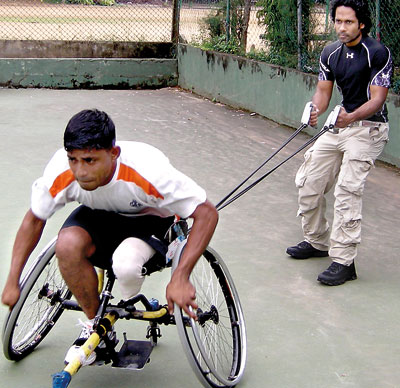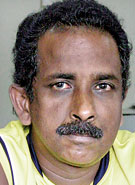Gamini unclips a lock in his plastic leg, takes it off, helps himself onto the wheelchair, straddles the fasteners, picks up a racquet and spins away onto the tennis court. His little daughter picks up her father’s plastic leg and follows him with pride. Gamini Dissanayake and Upali ‘Raja’ Rajakaruna are two soldiers disabled during active missions in the North, who are looking beyond the horrors of war through sport. Being a part of the Wheelchair Tennis programme of the Sri Lanka Tennis Federation, these dedicated soldiers are training for the 2012 London Paralympics.
Jagath Welikala, their chief coach has over 30 years of experience under his belt. “We started the Wheelchair Tennis Programme in 2002, and for the past seven years we have been training a batch of 30 disabled soldiers to excel in this sport,” he says. “These two alone have represented us at over 50 national tournaments and have won about 40.” Gamini and Raja have gained the championship titles at the Indian and Indonesian Open Wheelchair Tennis Championships and Raja has beaten the World 16th ranked player, while Gamini has beaten the World 20th.
 |
| Nothing is impossible: Gamini in training with Ranil |
Gamini Dissanayake joined the Army in 1996, and was serving in the Elephant Pass camp when a landmine blasted his leg. After treatment in the army hospital for eight months, he led a solitary life. In 2003, the Tennis Federation started the wheelchair tennis programme and Gamini was invited. “I hadn’t heard of nor had I seen tennis, I thought it was a crazy game at the start,” he confesses. “Mokatada bolayak passey roda putuwen elawanne” he quips saying that he found it a bit absurd to chase after a ball on a wheelchair.
During the programme, they were coached by an Australian trainer. They were told that 30 players would be selected from the pool after this session. The training began, Gamini and a friend purposely smashed the ball out of the park, hoping that they wouldn’t get selected to the squad. “Onawata epawata gahuwe, mata oney wune Camp ekata yanna,” Gamini says. Much to their dismay, she picked the ones who hit the ball the hardest, and Gamini was top of the list. Reluctantly Gamini started training a few weeks afterwards, and slowly started to find his place in the wheelchair tennis arena. Currently he is ranked No. 2 in the national rankings.
Upali ‘Raja’ Rajakaruna joined the army in 1993, and fell victim to a terrorist mortar attack during the ‘Jayasikuru’ operation. Raja may have lost his leg, but not his spirit. Joining the programme at the Tennis Federation in 2003, Raja was also picked into the group of 30 disabled soldiers. Unlike Gamini, Raja had a sports background. “I had played badminton and table tennis, I also used to swim back in those days,” says Raja, “Maybe that is why I managed to get the hang of this.” Raja is currently ranked No. 1.
“Our aim is to put them right at the top of the rankings. We have achieved so much so far, with a little more effort our Paralympics goal is in sight,” says Mr. Welikala. Gamini and Raja are the top ranked players in the national circuit, which automatically makes them the best suited for a Paralympics qualifying round, but there is another prerequisite. The players need to be in the Top 48 in the World rankings to enter the qualifying rounds. Currently Gamini is ranked 80th in the world, while Raja is 70th. “The players need more points to go up in the rankings, and that can only be done by winning international tournaments,” says Mr. Welikala. “But right now we are short of funds to send them for international tournaments.” The wheelchair tennis programme is not funded by any party or organization. “Commitment might well be our only motivator,” Mr. Welikala adds.
The deadline for Paralympics qualifications is May 31, 2012, which means that Gamini and Raja need to move up about 40 places within five months. The task would have been much easier if they hadn’t missed the recent championships in the Czech Republic, Russia and Australia. Money and not physical limitations may be the only barrier stopping these two motivated players from reaching the top.
P.S. Kumara, Chairman of the committee in charge and a former national champion who holds the distinction of being the only player from Sri Lanka to represent the country at the Australian Open, says the hunt for funding is a distraction. “If we had sufficient funding everybody could stick to the job they are best at,” he says.
 |
| Jagath Welikala |
Ranil Harshana, a fitness expert and a Level 2 tennis coach, has been actively involved in keeping the two soldiers fit and ready. Ranil has conducted many workshops and programmes on tennis and sports conditioning and believes that proper training and dedication can make the dream of a Paralympics medal, a reality. “People always ask for high tech training equipment, but we only have a pair of dumbbells, medicine ball and a pair of training straps,” he says. “This is all I need to train them to perfection, it’s more about the training technique – I push these guys to a maximum.” The soldiers smilingly remark that the Army training seems to be less rigorous than Ranil’s programme.
Gamini takes to the court in his old rugged wheelchair. The wheelchair has been taped up, more than once, but Gamini displays immense agility through it all. “If these players have achieved their feats while playing on wheelchairs like this, imagine the heights they could reach if they are provided with special wheelchairs?” Ranil says. There are no brakes on the wheelchair, you have to stop it manually adding to the already daunting task of chasing the ball, flipping from side-to-side and carrying out the strike. “The World No.1 ranked player has a custom-made wheelchair, while our players have old, battered ones. It’s like racing a Maruti against a Lamborghini.”
A special wheelchair named ‘Titanium’ is available but once again, money is the problem. The cost of one wheelchair is $5000, and currently the programme committee of the federation is finding it hard to find the cash. The titanium wheelchairs will allow them to gain up to 20 times more speed and agility. While appealing for generous sponsors who are willing to help them achieve their dream of bringing a Paralympics medal to Sri Lanka, the soldiers toil hard, hoping to reach their ultimate objective. Gamini’s daughter hands him the leg, and he straps it on, as they walk hand in hand, after another hard day of practice. |



